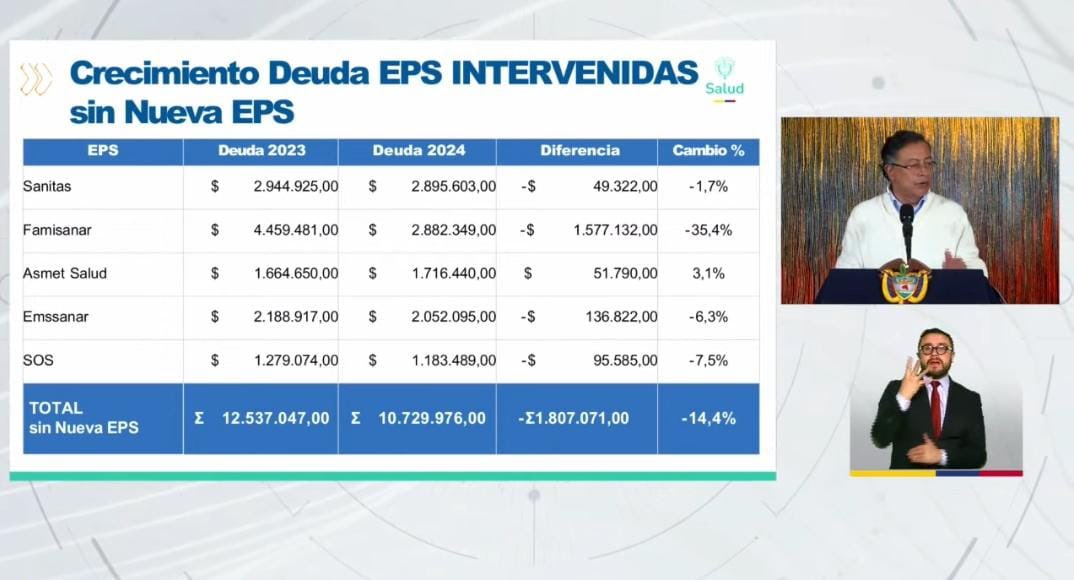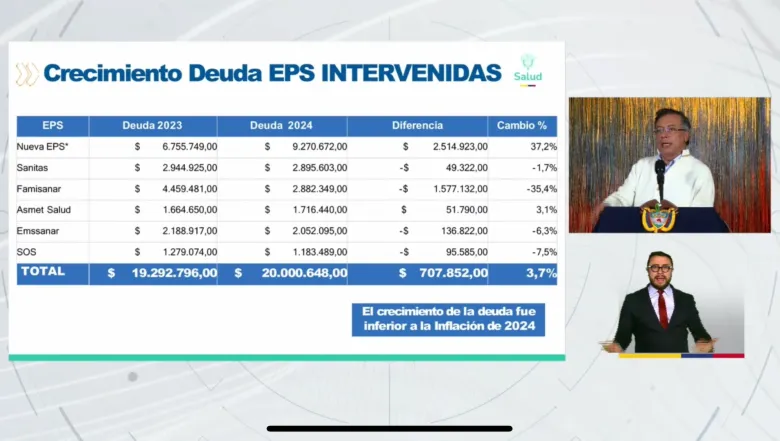President Petro reportedly presented incomplete data on the debts of the intervened EPS: in reality, the debt would be $25 billion, not $20 billion.

On July 15, during a speech and subsequent Council of Ministers meeting, President Gustavo Petro stated that during his administration, debts at intervened EPSs have been reduced. The president presented several charts showing a decrease in the portfolios of some of the intervened insurance companies.
In four of them (Sanitas, Famisanar, Emsanar, and SOS), debt is decreasing, while in two others (Nueva EPS and Asmet Salud), debt is increasing. According to the government, in 2023, the debts of five EPSs (excluding Nueva EPS) amounted to $12.5 billion, and in 2024, those figures decreased to $10.7 billion, resulting in a decrease in liabilities of $1.8 billion pesos.

Reduction in EPS debts presented by President Gustavo Petro. Photo: Presidency
When Nueva EPS's debts are added to the figures, a table also presented by President Petro, the debt increases by $707 billion pesos. This, in any case, the president defended as a triumph because "the debt growth was lower than the 2024 inflation rate," according to what was stated in his presentation.

Debt reduction with the Nueva EPS data presented by President Petro. Photo: Presidency
In this regard, according to data provided by the government, the overall increase in debt across these six EPSs under intervention was 3.7%, rising from $19.2 billion pesos in 2023 to $20 billion in 2024.
It is important to note that in the case of Nueva EPS, these figures are preliminary, as the company has not yet submitted its financial statements for 2023 and 2024, making it impossible to fully understand the full extent of its financial statements. So far, only data that cannot be audited with certainty is available.
However, President Petro's presentation omits, without explanation, the debt of three EPSs that are also currently under intervention: Savia Salud, Coosalud, and Capresoca. Now, a report by Acemi, the EPS union, shows that contrary to President Petro's claims, the liabilities of the intervened EPSs far exceed the figures reported during his speech and are even falsified, as they do not match those reported by the National Health Superintendency.
According to the data presented, by omitting the three intervened EPSs, the Presidency significantly changed the overall debt presented. This is because adding the missing debts to the account shows that the total liabilities in 2024 actually amounted to $25.1 billion pesos, not the $20 billion officially reported.

President Gustavo Petro during his speech on July 15. Photo: Ovidio González - Office of the President
The increase in debt, according to data presented by Acemi, is seen as follows in the intervened insurers: at Coosalud, for example, the debt went from 843 billion pesos in 2023 to $2.8 trillion pesos in 2024 (leaving a real liability of $1.9 trillion); in the case of Savia Salud, the debt went from $969 billion in 2023 to $1.2 trillion in 2024 (leaving an increase in liabilities of $280 billion); while at Capresoca, the debt reached 260 billion in 2023 to 318 billion pesos in 2024 (leaving a liability of $58 billion).
Furthermore, there are government figures that do not coincide with those officially reported by the Supersalud. The debts presented by the government in the presidential address show a decrease of $2 trillion pesos in Famisanar's debts between 2023 and 2024. According to data from the Presidency, in 2023 the debts amounted to $4.4 trillion pesos and in 2024 they reached $2.8 trillion.
Acemi doesn't understand this figure. In reality, based on official data reported to the National Health Superintendency, which is where the debt data used for the report comes from, Famisanar's debts did not decrease but rather grew, reaching $2.5 billion in 2023 and $3 billion in 2024. The same is true for Sanitas and SOS, where debts are not decreasing but rather growing.
In this regard, the figures from the government and Acemi, which uses data from the Supersalud (Health Superintendency of Health), differ, but they clearly show that the government effectively omitted data from EPSs where debts are growing and also changed data from other intervened EPSs to show that the intervention was indeed having positive effects.
Environment and Health Journalist
eltiempo





